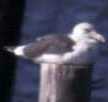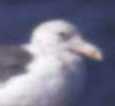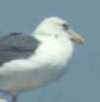The Photos

|

|

|
| A | B | C |

|

|

|
| D | E | F |
since December 20, 1999
Bill Smith (pwsmith@techline.com) writes:
To the best of my knowledge, no one has attempted to apply "modern
gull identification techniques" (if there really is such a thing :-) to
this bird.
Go for it, folks!
Next three, taken 9/17/78 by me. Fully adult plumage and bright pink
legs--this is when I and friends refound the bird (not seen in the
intervening months) and realized based on leg-color that it couldn't be
adult LBBG. These slides were sent to many people who agreed it was not
LBBG. Many felt it was Western Gull,
but few could be certain.
Later other photos were taken by me on 9/19/81. The bird reappears after not
being seen for 3 years! Now armed with all the things people told me I
should have looked for previously (eye-ring color, etc.) I became
convinced that it is Western Gull, and published it in Amer. Birds.
Others rejected this idea out of hand and concocted a hybrid GBBG and
LBBG without considering the general lack of breeding range overlap
of those species.
One interesting feature seen in the very first slide (by M. L. Mattis,
1 Nov 77) is that the bird is clearly smaller than typical Herring
Gulls. This pointed toward LBBG originally when leg-color was not
decisive (and when much less info about gull ID was known). Some
rejected Western Gull based on this size. In fact there is a big
variation in Western Gulls-- I have photographed two standing
side-by-side with very different body sizes.